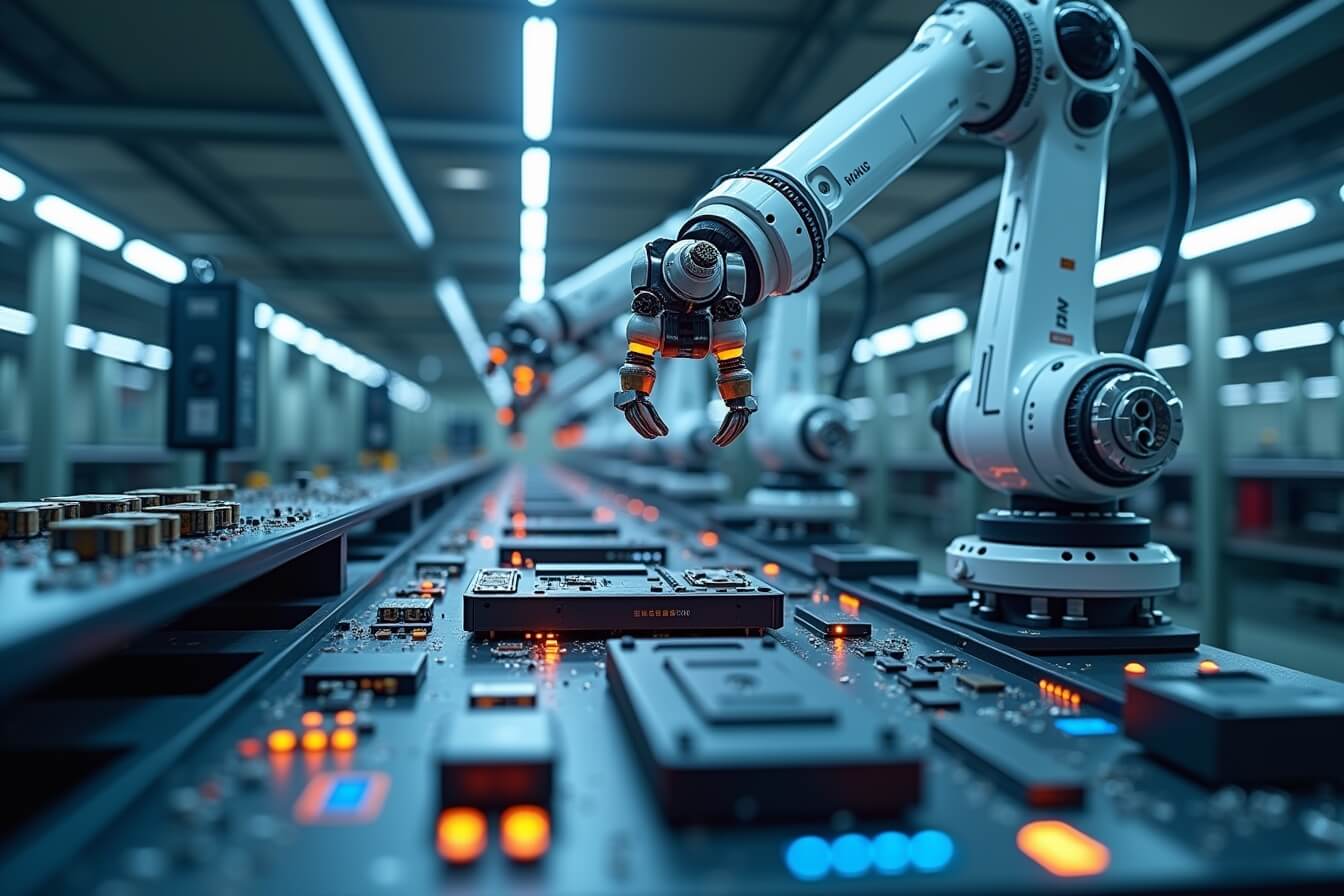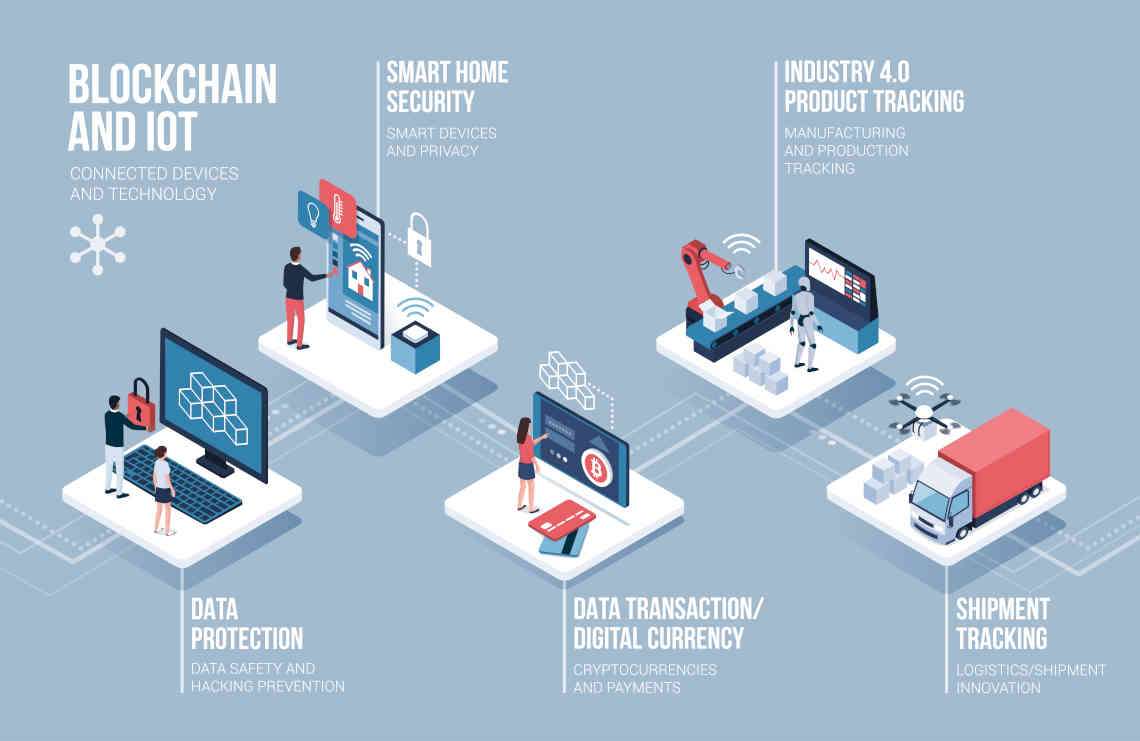블록체인과 사물인터넷

Blockchain provides a decentralized and tamper-proof solution, ensuring trust and security in an increasingly connected world.
The convergence of Blockchain and the Internet of Things (IoT) is revolutionizing industries by enhancing security, transparency, and automation. As IoT devices become more embedded in daily operations, concerns over data security, device interoperability, and network efficiency continue to grow.
블록체인이란 무엇입니까?
Blockchain is a series of fixed pieces of information. That information is time-stamped and managed by a cluster of systems not owned by one entity. It secures all the information and connects it by using cryptographic principles. Blockchain has no central authority since its ledger is immutable and shared. The data in it is open for any and everyone to view.
Therefore, anything built on blockchain is transparent to all by nature. All users are accountable for what they do. It has no transaction cost – it is an easy and effective way of passing information from one point to the other.
What is the IoT?

What are we referring to when we speak about the Internet of Things? The IoT includes everything from coffeemakers to cellphones. It also includes headphones, washing machines, lamps, wearable devices, and most other appliances. The IoT also refers to machine components. Examples include the drill of an oil rig and the jet engine of an airplane.
Other examples of “things” are vehicles, handheld electronics, devices, and home appliances. We’re also talking about sensors, mobile phones, and thermostats. The Internet of Things, or IoT, links any device with an on/off switch to the Internet.
Why Blockchain and IoT Matter Together
IoT devices generate massive amounts of real-time data across industries, but traditional cloud-based systems pose security risks and inefficiencies. Blockchain technology introduces decentralization, transparency, and immutability, allowing devices to interact securely without intermediaries.
✅ Enhanced Security against cyberattacks and data breaches
✅ Improved Device-to-Device Communication with secure transactions
✅ Real-Time Tracking for supply chains, healthcare, and smart cities
✅ Automated Smart Contracts for seamless operations
Uses and Applications of IoT

최근 몇 년 동안 업계가 발전했습니다. 앞으로 더욱 성장할 것이라는 예측과 추정이 있습니다. 우리는 IoT 장치 간의 연결을 높이기 위해 블록체인을 어떻게 활용할 수 있는지 살펴보았습니다. 앞으로 우리가 탐구할 수 있는 다양한 다른 용도가 있습니다.
- 첫 번째 용도는 데이터 보안 분야입니다. 최근 우리는 기업, 특히 스타트업에서 많은 보안 문제를 경험했습니다. 사이버 범죄자는 일반적으로 회사 인프라 내에서 취약한 부분을 찾습니다.
- We can also use IoT to analyze information. Several companies revolve around data and information. They work to leverage it for their general use. Due to this, larger ecosystems that exchange and use data make use of IoT.
- 데이터 개인 정보 보호 및 저장 영역에 이를 적용할 수 있습니다. 기업은 판매하거나 사용하는 데이터의 양에 대해 책임을 집니다. 데이터에 액세스하고 이를 보호하는 것은 어려울 수 있습니다. 블록체인 기술을 사용하면 관리가 훨씬 쉬워집니다.
- 공급망에서 IoT를 사용할 수 있습니다. 전 세계의 공급망에는 다양한 위치에 걸쳐 많은 당사자가 참여합니다. 예로는 식품 및 제약 회사의 유통업체가 있습니다. 모든 공급망은 IoT와 블록체인의 조합을 사용할 수 있습니다.
Key Applications of Blockchain and IoT
1. Supply Chain Management & Logistics
IoT sensors track goods in real-time, while blockchain ensures tamper-proof records of product movement.
🔹 이익:
-
-
Real-time product tracking from manufacturing to delivery
-
Fraud prevention through immutable transaction records
-
Enhanced efficiency and reduced operational costs
-
2. Smart Cities and Infrastructure
Blockchain and IoT power smart cities with efficient, secure, and autonomous systems.
🔹 이익:
-
-
Traffic management using IoT-connected smart lights
-
Secure identity verification for public services
-
Optimized energy usage through blockchain-based smart grids
-
3. Healthcare & Medical Data Security
Blockchain enhances IoT-driven healthcare solutions by ensuring data integrity and patient privacy.
🔹 Applications:
-
-
Secure storage of patient health records
-
Remote monitoring of chronic disease patients
-
Smart medical devices with blockchain-based authentication
-
4. Automotive and Connected Vehicles
Blockchain enables secure communication between IoT-connected vehicles and smart road infrastructure.
🔹 How it works:
-
-
Autonomous vehicles share real-time data securely
-
Decentralized ledgers prevent vehicle software hacks
-
Smart contracts automate toll payments and insurance claims
-
5. Industrial IoT & Manufacturing
Blockchain secures IoT-based manufacturing processes, ensuring trust and efficiency.
🔹 Key Innovations:
-
-
Real-time tracking of factory operations
-
Preventing counterfeit parts through blockchain verification
-
AI-powered predictive maintenance
-
Challenges in Blockchain and IoT Integration

While the benefits are vast, businesses must address key challenges:
1. Scalability Issues
Blockchain networks must process vast amounts of IoT-generated data without slowing down operations.
2. High Implementation Costs
Setting up blockchain infrastructure requires significant investment in hardware, software, and expertise.
3. Security Vulnerabilities in IoT Devices
IoT endpoints remain vulnerable to cyberattacks, making strong security protocols essential.
4. Regulatory and Compliance Hurdles
Industries must navigate data privacy laws and government regulations when implementing blockchain.
The Future of Blockchain and IoT
Emerging innovations will further enhance the blockchain-IoT ecosystem, including:
✅ AI-driven analytics for predictive insights
✅ Zero-trust security models for enhanced IoT data protection
✅ Decentralized identity solutions for connected devices
✅ 5G and Edge Computing accelerating real-time blockchain transactions
Final Thoughts from Ruth Stanat, CEO of SIS International Research
~에 SIS 국제 연구, we provide market intelligence, blockchain adoption strategies, and IoT research insights to help businesses implement secure and scalable blockchain solutions.
뉴욕에 있는 우리 시설 위치
11 E 22nd Street, Floor 2, New York, NY 10010 전화: +1(212) 505-6805
SIS 인터내셔널 소개
SIS 국제 정량적, 정성적, 전략 연구를 제공합니다. 우리는 의사결정을 위한 데이터, 도구, 전략, 보고서 및 통찰력을 제공합니다. 또한 인터뷰, 설문 조사, 포커스 그룹, 기타 시장 조사 방법 및 접근 방식을 수행합니다. 문의하기 다음 시장 조사 프로젝트를 위해.



